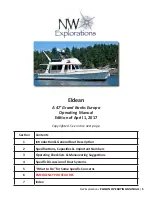
255 Owner’s Manual
3-3
Operating Information
3. Moor your boat securely to the dock. Know the
location of the fire extinguisher in case of
emergency.
4. Keep accurate records of your fuel
consumption. A fuel log tracking fuel use over
time will help determine average consumption.
5. Close all doors, hatches, windows and other
compartments.
6. Extinguish cigarettes, pipes, and all other flame
producing items.
7. Make sure all power is off, and do not operate
any electrical switches.
8. Remove the fuel filler cap.
9. Insert the hose nozzle and make sure nozzle is
in contact with or grounded against fill opening.
This will reduce the risk of static spark.
When your boat is equipped with the pop-up fuel
filler cap, open by pressing the cap and turning the
cap counterclockwise (approximately 10°); remove
cap.
To close:
Reinstall cap, press and turn clockwise. The fuel
cap key is not necessary unless the cap is
overtightened.
10. Add fuel in accordance with the propulsion unit
operator’s manual. Do not overfill, and allow
enough room for fuel expansion.
The fuel cap is retained by a chain, to prevent
losing the cap after it is opened. Be careful when
fueling to prevent damaging the chain. If it breaks,
have it replaced.
After Fueling:
1. Tighten the fuel fill cap using the fuel cap key,
unless your filler cap is the pop-up type. Wipe
up any fuel spills.
2. Open all windows, hatches, doors and
compartments.
3. Check all fuel lines, hoses and connections for
leaks and deterioration.
4. Be sure to run the blower for at least four
minutes before starting the engine. If you smell
gasoline fumes, do not start the engine;
continue to run the blower until fumes have
dissipated.
Launching
Launching Checklist
Federal and local laws require certain safety
equipment to be onboard at all times. In addition,
responsible boaters carry other equipment in case
of an emergency. Check with local boating
authorities for any additional requirements over and
above federal requirements.
For maximum enjoyment and safety, check each of
these items BEFORE launching:
• Install drain plug.
• Have enough personal flotation devices for
every person onboard.
• Be sure the steering system operates smoothly
and properly.
• Verify the amount of fuel in the fuel tanks.
• Verify the batteries are fully charged.
• Check weather conditions.
• Be sure the lights, horn, bilge pumps and other
electrical equipment are in proper operating
condition.
KC-0991
COB_0040_A
COB_255_OM_forWeb.book Page 3 Friday, June 9, 2006 2:23 PM
















































